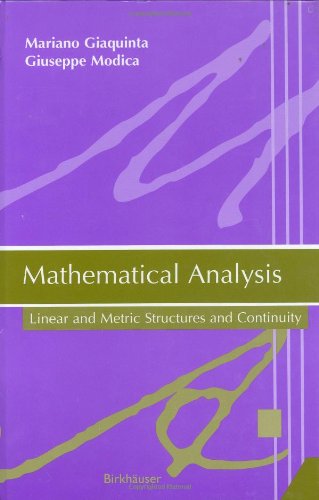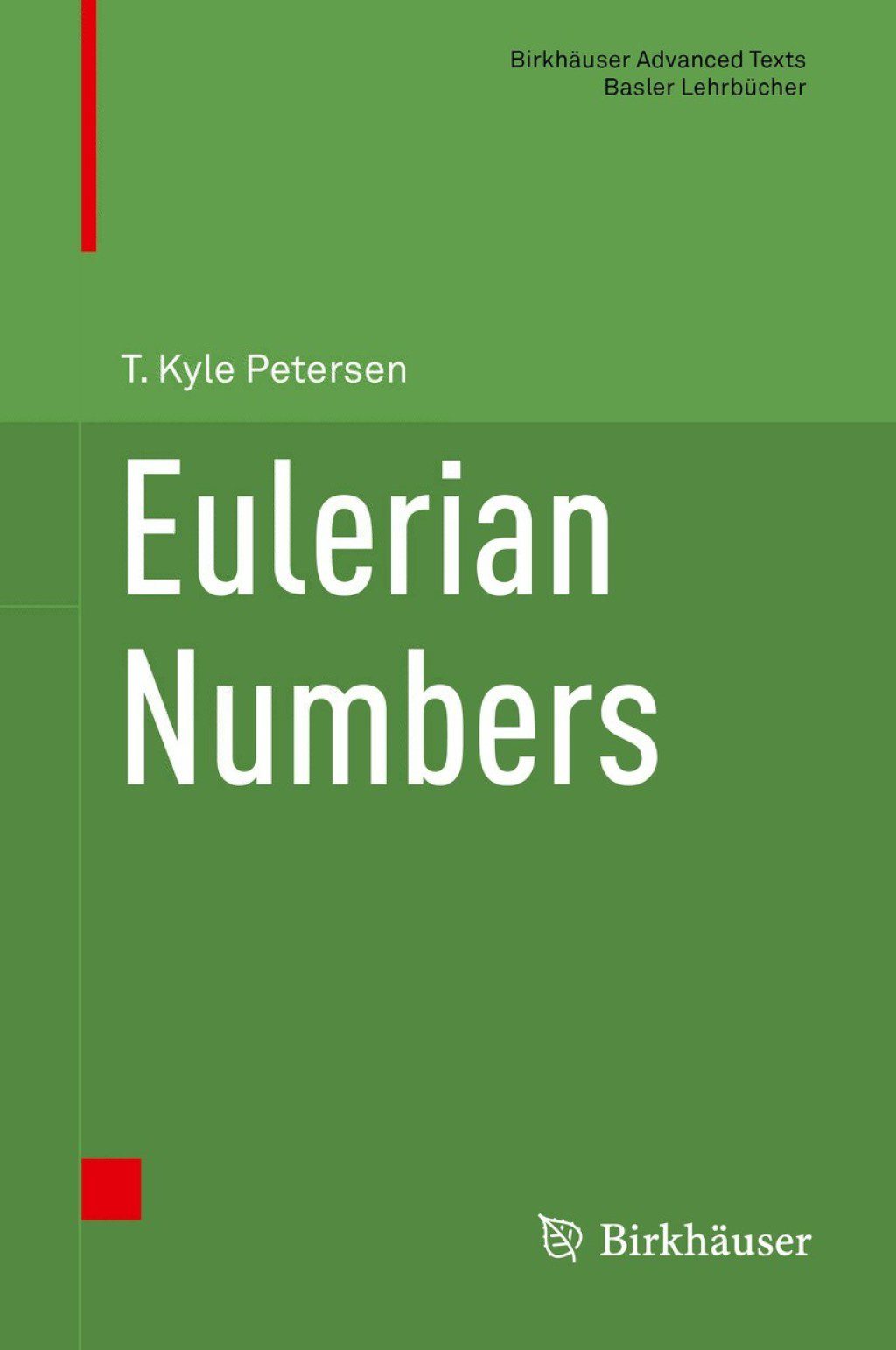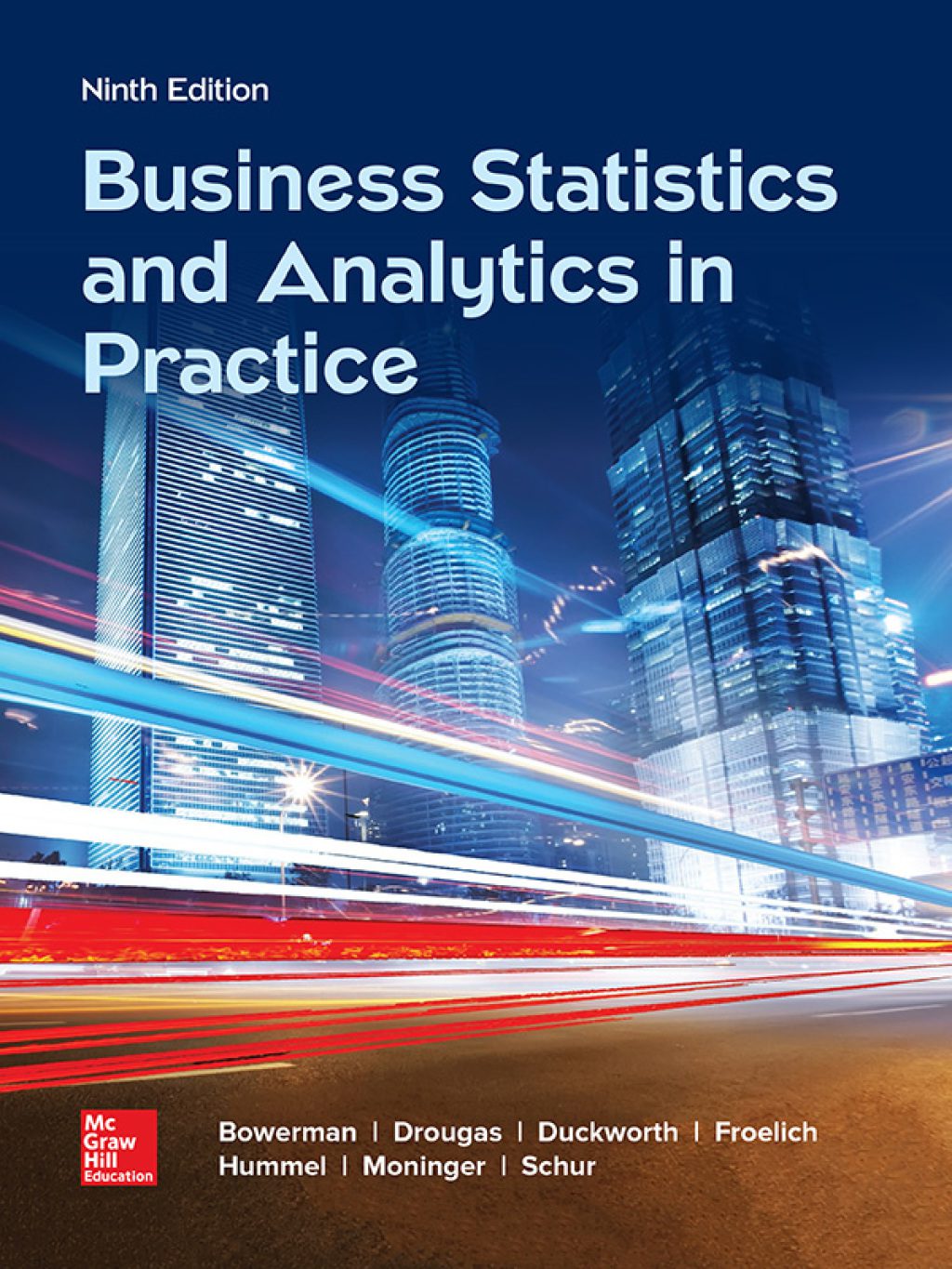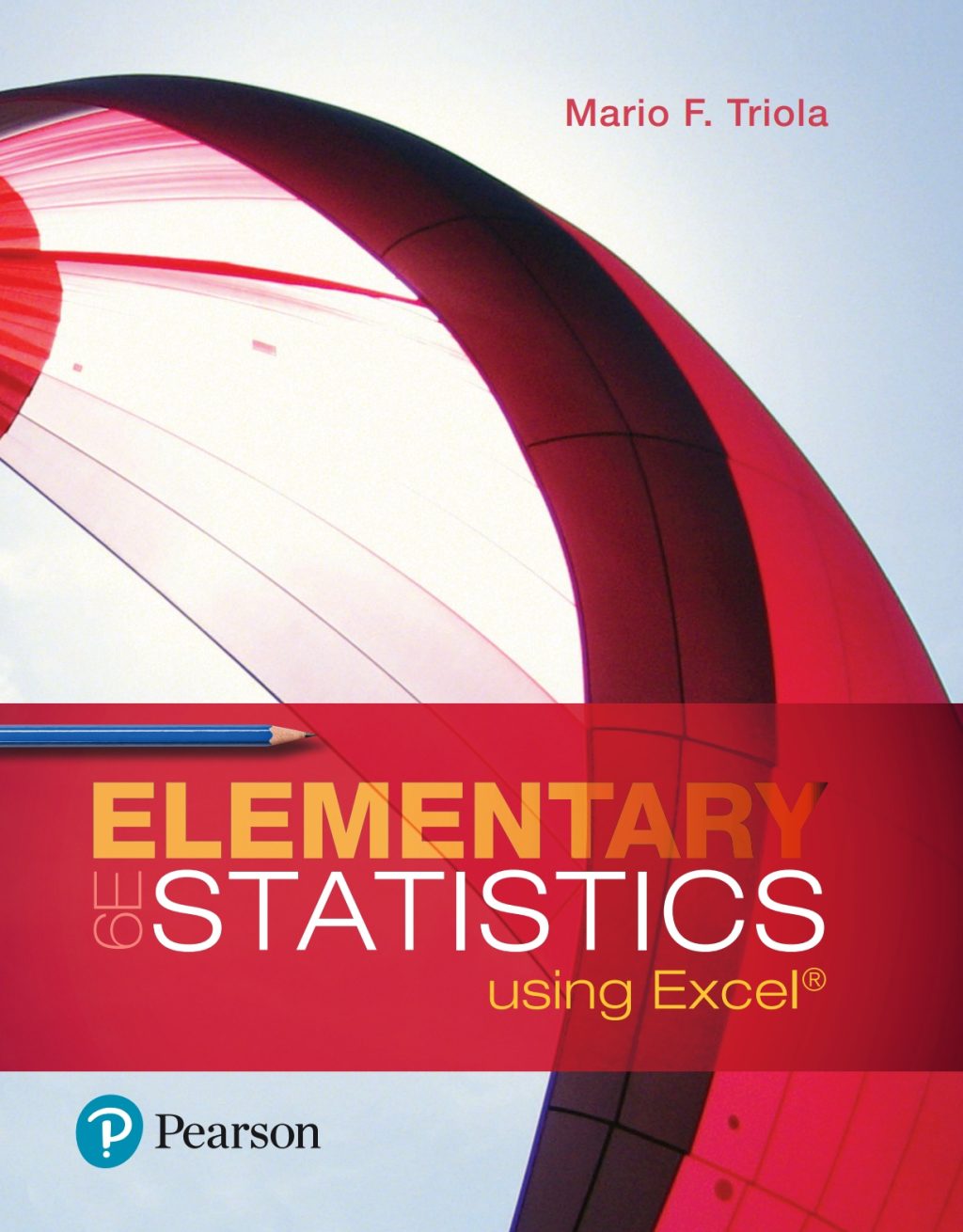Mariano Giaquinta, Giuseppe Modica0817643745, 9780817643744
The book is divided into three parts. The first part introduces the basic ideas of linear and metric spaces, including the Jordan canonical form of matrices and the spectral theorem for self-adjoint and normal operators. The second part examines the role of general topology in the context of metric spaces and includes the notions of homotopy and degree. The third and final part is a discussion on Banach spaces of continuous functions, Hilbert spaces and the spectral theory of compact operators.
Mathematical Analysis: Linear and Metric Structures and Continuity motivates the study of linear and metric structures with examples, observations, exercises, and illustrations. It may be used in the classroom setting or for self-study by advanced undergraduate and graduate students and as a valuable reference for researchers in mathematics, physics, and engineering.
Other books recently published by the authors include: Mathematical Analysis: Functions of One Variable, and Mathematical Analysis: Approximation and Discrete Processes. This book builds upon the discussion in these books to provide the reader with a strong foundation in modern-day analysis.
Table of contents :
Cover ……Page 1
Title page ……Page 3
Date-line ……Page 4
Preface ……Page 5
Contents ……Page 9
Part I. Linear Algebra ……Page 21
a. Linear combinations ……Page 23
b. Basis ……Page 26
c. Dimension ……Page 27
d. Ordered basis ……Page 29
1.2 Matrices and Linear Operators ……Page 30
a. The algebra of matrices ……Page 31
b. A few special matrices ……Page 32
c. Matrices and linear operators ……Page 33
d. Image and kernel ……Page 35
f. Parametric and implicit equations of a subspace ……Page 38
a. Linear systems and the language of linear algebra ……Page 42
b. The Gauss elimination method ……Page 44
c. The Gauss elimination procedure for nonhomogeneous linear systems ……Page 49
1.4 Determinants ……Page 51
1.5 Exercises ……Page 57
a. Definition ……Page 61
b. Subspaces, linear combinations and bases ……Page 62
c. Linear maps ……Page 64
d. Coordinates in a finite-dimensional vector space ……Page 65
e. Matrices associated to a linear map ……Page 67
f. The space $mathcal{L}(X,Y)$ ……Page 69
g. Linear abstract equations ……Page 70
h. Changing coordinates ……Page 71
i. The associated matrix under changes of basis ……Page 73
j. The dual space $mathcal{L}(X,mathbb{K})$ ……Page 74
k. The bidual space ……Page 75
l. Adjoint or dual maps ……Page 76
2.2 Eigenvectors and Similar Matrices ……Page 77
a. Eigenvectors and eigenvalues ……Page 78
c. The characteristic polynomial ……Page 80
e. Diagonizable matrices ……Page 82
f. Triangularizable matrices ……Page 84
2.2.2 Complex matrices ……Page 85
a. The Cayley-Hamilton theorem ……Page 86
b. Factorization and invariant subspaces ……Page 87
c. Generalized eigenvectors and the spectral theorem ……Page 88
d. Jordan’s canonical form ……Page 90
e. Elementary divisors ……Page 95
2.3 Exercises ……Page 96
a. Euclidean spaces ……Page 99
b. Hermitian spaces ……Page 102
c. Orthonormal basis and the Gram-Schmidt algorithm ……Page 105
d. Isometries ……Page 107
e. The projection theorem ……Page 108
f. Orthogonal subspaces ……Page 110
g. Riesz’s theorem ……Page 111
h. The adjoint operator ……Page 112
a. Bilinear forms and linear operators ……Page 115
c. Sylvester’s theorem ……Page 117
d. Existence of $g$-orthogonal bases ……Page 119
e. Congruent matrices ……Page 121
f. Classification of real metrics ……Page 123
g. Quadratic forms ……Page 124
h. Reducing to a sum of squares ……Page 125
3.3 Exercises ……Page 129
a. Self-adjoint operators ……Page 131
b. The spectral theorem ……Page 132
c. Spectral resolution ……Page 134
d. Quadratic forms ……Page 135
e. Positive operators ……Page 137
f. The operators $A^ast A$ and $AA^ast$ ……Page 138
g. Powers of a self-adjoint operator ……Page 139
b. Normal operators on Hermitian spaces ……Page 141
c. Normal operators on Euclidean spaces ……Page 142
a. The operator $A^ast A$ ……Page 145
b. Singular value decomposition ……Page 146
c. The Moore-Penrose inverse ……Page 147
a. The method of least squares ……Page 148
4.2.2 Trigonometric polynomials ……Page 150
a. Spectrum and products ……Page 151
b. Sampling of trigonometric polynomials ……Page 152
c. The discrete Fourier transform ……Page 154
a. Systems of linear difference equations ……Page 156
b. Power of a matrix ……Page 157
4.2.4 An ODE system: small oscillations ……Page 161
4.3 Exercises ……Page 163
Part II. Metrics and Topology ……Page 167
5. Metric Spaces and Continuous Functions ……Page 169
a. Metrics ……Page 171
b. Convergence ……Page 173
5.1.2 Examples of metric spaces ……Page 174
a. Metrics on finite-dimensional vector spaces ……Page 175
b. Metrics on spaces of sequences ……Page 177
c. Metrics on spaces of functions ……Page 179
a. Lipschitz-continuous maps between metric spaces ……Page 181
b. Continuous maps in metric spaces ……Page 182
c. Limits in metric spaces ……Page 184
d. The junction property ……Page 185
a. The vector space $C^0(A,mathbb{R}^m)$ ……Page 186
b. Some nonlinear continuous transformations from $mathbb{R}^n$ into $mathbb{R}^N$ ……Page 187
c. The calculus of limits for functions of several variables ……Page 191
5.2 The Topology of Metric Spaces ……Page 194
b. Closed sets ……Page 195
c. Continuity ……Page 196
d. Continuous real-valued maps ……Page 197
e. The topology of a metric space ……Page 198
f. Interior, exterior, adherent and boundary points ……Page 199
g. Points of accumulation ……Page 200
h. Subsets and relative topology ……Page 201
a. Topological spaces ……Page 202
c. Separation properties ……Page 204
a. Complete metric spaces ……Page 205
b. Completion of a metric space ……Page 206
c. Equivalent metrics ……Page 207
e. Baire’s theorem ……Page 208
5.4 Exercises ……Page 210
a. Sequential compactness ……Page 217
b. Compact sets in $mathbb{R}^n$ ……Page 218
c. Coverings and $epsilon$-nets ……Page 219
a. The Weierstrass theorem ……Page 221
c. Continuity of the inverse function ……Page 222
6.1.3 Semicontinuity and the Frechet-Weierstrass theorem ……Page 223
6.2.1 Uniformly continuous functions ……Page 225
6.2.2 Extending uniformly continuous functions to the closure of their domains ……Page 226
a. Lipschitz-continuous functions ……Page 227
6.2.4 Tietze’s theorem ……Page 228
6.3.1 Connected spaces ……Page 230
b. Connected components ……Page 231
c. Segment-connected sets in $mathbb{R}^n$ ……Page 232
d. Path-connectedness ……Page 233
6.3.2 Some applications ……Page 234
6.4 Exercises ……Page 236
7.1.1 Curves and trajectories ……Page 239
a. The calculus ……Page 242
c. Equivalent parametrizations ……Page 243
a. Regular curves ……Page 244
b. Tangent vectors ……Page 245
c. Length of a curve ……Page 246
d. Arc length and $C^1$-equivalence ……Page 252
7.1.3 Some celebrated curves ……Page 253
a. Spirals ……Page 254
b. Conchoids ……Page 256
c. Cissoids ……Page 257
e. The cycloid ……Page 258
f. The catenary ……Page 260
a. Functions of bounded variation and rectifiable curves ……Page 261
b. Lipschitz and intrinsic reparametrizations ……Page 263
7.2.1 Real functions with bounded variation ……Page 264
a. The Cantor-Vitali function ……Page 265
7.3 Exercises ……Page 267
8. Some Topics from the Topology of $mathbb{R}^n$ ……Page 269
a. Homotopy of maps ……Page 270
b. Homotopy classes ……Page 272
c. Homotopy equivalence of sets ……Page 273
d. Relative homotopy ……Page 276
b. The group structure on $pi_1(X,x_0)$ ……Page 277
c. Changing base point ……Page 278
d. Invariance properties of the fundamental group ……Page 279
a. Covering spaces ……Page 280
b. Lifting of curves ……Page 281
d. A global invertibility result ……Page 284
a. The fundamental group of $S^1$ ……Page 286
c. The fundamental group of $S^n$, $n geq 2$ ……Page 287
a. The degree of maps $S^1 to S^1$ ……Page 288
b. An integral formula for the degree ……Page 289
c. Degree and inverse image ……Page 290
d. The homological definition of degree for maps $S^1 to S^1$ ……Page 291
a. Brouwer’s degree ……Page 292
b. Extension of maps into $S^n$ ……Page 293
c. Brouwer’s fixed point theorem ……Page 294
d. Fixed points and solvability of equations in $mathbb{R}^{n+1}$ ……Page 295
e. Fixed points and vector fields ……Page 296
8.2.2 Borsuk’s theorem ……Page 298
8.2.3 Separation theorems ……Page 299
8.3 Exercises ……Page 301
Part III. Continuity in Infinite-Dimensional Spaces ……Page 303
9.1.1 Definitions and basic facts ……Page 305
a. Norms induced by inner and Hermitian products ……Page 307
c. Series in normed spaces ……Page 308
d. Finite-dimensional normed linear spaces ……Page 310
a. The space $mathcal{l}_p$, $1 leq p < infty$ ……Page 312
b. A normed space that is not Banach ……Page 313
c. Spaces of bounded functions ……Page 314
a. Uniform convergence ……Page 315
c. A convergence diagram ……Page 317
d. Uniform convergence on compact subsets ……Page 319
a. Equicontinuous functions ……Page 320
b. The Ascoli-Arzela theorem ……Page 321
a. Weierstrass’s approximation theorem ……Page 323
b. Bernstein’s polynomials ……Page 325
c. Weierstrass’s approximation theorem for periodic functions ……Page 327
a. Convolution product ……Page 329
b. Mollifiers ……Page 332
c. Approximation of the Dirac mass ……Page 333
9.3.3 The Stone-Weierstrass theorem ……Page 336
a. Baire’s approximation theorem ……Page 339
b. Approximation in metric spaces ……Page 340
9.4.1 Basic facts ……Page 342
a. Continuous linear forms and hyperplanes ……Page 343
c. Norms on matrices ……Page 344
d. Pointwise and uniform convergence for operators ……Page 345
e. The algebra End($X$) ……Page 346
9.4.2 Fundamental theorems ……Page 347
a. The principle of uniform boundedness ……Page 348
b. The open mapping theorem ……Page 349
c. The closed graph theorem ……Page 350
d. The Hahn-Banach theorem ……Page 351
9.5 Some General Principles for Solving Abstract Equations ……Page 354
a. The fixed point theorem ……Page 355
b. The continuity method ……Page 357
a. Compact maps ……Page 359
b. The Caccioppoli-Schauder theorem ……Page 361
9.5.3 The method of super- and sub-solutions ……Page 362
a. Ordered Banach spaces ……Page 363
9.6 Exercises ……Page 364
a. Definitions and examples ……Page 371
b. Orthogonality ……Page 374
b. Separable Hilbert spaces ……Page 375
c. Fourier series and $mathcal{l}_2$ ……Page 377
d. Some orthonormal polynomials in $L^2$ ……Page 380
10.2 The Abstract Dirichlet’s Principle and Orthogonality ……Page 383
a. The abstract Dirichlet’s principle ……Page 384
b. Riesz’s theorem ……Page 386
c. The orthogonal projection theorem ……Page 387
10.3 Bilinear Forms ……Page 388
b. Adjoint operator ……Page 389
c. Bilinear forms ……Page 390
a. Inner products ……Page 391
b. Green’s operator ……Page 392
c. Ritz’s method ……Page 393
d. Linear regression ……Page 394
a. The Lax-Milgram theorem ……Page 396
b. Faedo-Galerkin method ……Page 397
a. Linear compact operators ……Page 398
b. The alternative theorem ……Page 399
c. Some facts related to the alternative theorem ……Page 401
d. The alternative theorem in Banach spaces ……Page 403
e. The spectrum of compact operators ……Page 404
a. Self-adjoint operators ……Page 405
b. Spectral theorem ……Page 407
c. Compact normal operators ……Page 408
d. The Courant-Hilbert-Schmidt theory ……Page 410
e. Variational characterization of eigenvalues ……Page 412
10.5 Exercises ……Page 413
a. Semicontinuity of the length ……Page 415
b. Compactness ……Page 416
11.1.2 A minimum problem in a Hilbert space ……Page 417
a. Weak convergence in Hilbert spaces ……Page 418
b. Existence of minimizers of convex coercive functionals ……Page 420
11.2 A Theorem by Gelfand and Kolmogorov ……Page 422
11.3 Ordinary Differential Equations ……Page 423
a. Velocities of class $C^k(D)$ ……Page 424
b. Local existence and uniqueness ……Page 425
c. Continuation of solutions ……Page 427
d. Systems of higher order equations ……Page 429
e. Linear systems ……Page 430
f. A direct approach to Cauchy problem for linear systems ……Page 431
g. Continuous dependence on data ……Page 433
h. The Peano theorem ……Page 435
11.3.2 Boundary value problems ……Page 436
a. The shooting method ……Page 438
b. A maximum principle ……Page 439
c. The method of super- and sub-solutions ……Page 441
d. A theorem by Bernstein ……Page 443
11.4.1 Some motivations ……Page 444
b. Materials with memory ……Page 445
c. Boundary value problems ……Page 446
e. Dynamics of an elastic thread ……Page 447
11.4.2 Volterra integral equations ……Page 449
11.4.3 Fredholm integral equations in $C^0$ ……Page 450
11.5 Fourier’s Series ……Page 451
11.5.1 Definitions and preliminaries ……Page 453
a. Dirichlet’s kernel ……Page 455
a. The Riemann-Lebesgue theorem ……Page 456
b. Regular functions and Dini test ……Page 457
a. Fourier’s partial sums and orthogonality ……Page 459
b. A first uniform convergence result ……Page 460
c. Energy equality ……Page 461
a. A variant of the Riemann-Lebesgue theorem ……Page 462
b. Uniform convergence for Dini-continuous functions ……Page 464
a. The primitive of the Dirichlet kernel ……Page 465
b. Gibbs’s phenomenon ……Page 467
a. The Dirichlet-Jordan test ……Page 469
b. Fejer example ……Page 471
11.5.7 Fejer’s sums ……Page 472
A. Mathematicians and Other Scientists ……Page 475
B. Bibliographical Notes ……Page 477
C. Index ……Page 479







Reviews
There are no reviews yet.